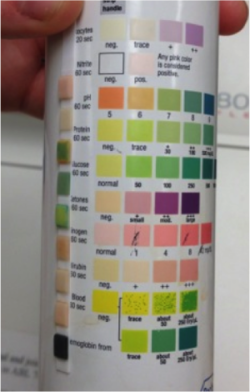An Equine Emergency
 Monday, September 22, 2014 at 12:00PM
Monday, September 22, 2014 at 12:00PM  Figure 1: Das Hit in competition at Woodside, Ca less than one month before presentation.
Figure 1: Das Hit in competition at Woodside, Ca less than one month before presentation.
Mindy Nelson, UC Davis
Cases/Abstracts, Winner
Das Hit presented at 2237 on 8/12/14 for an emergency visit to the Large Animal Equine Medicine service at the William R. Pritchard Veterinary Medical Teaching Hospital at the University of California, Davis. She is a 7 year-old Oldenburg mare used for dressage riding (Fig. 1) and is insured for major medical. She presented for a history of fever, neck swelling, and red-brown urine. The history of this mare’s present illness began on August 6, when her owner noted swelling and pain in the left side of the neck and called her veterinarian. Bloodwork on that day showed an elevated WBC count. The owner’s mother reported that no intramuscular injections had been given and that no respiratory, pigeon fever or strangles-like symptoms were present in any of the other horses at the farm. The treatment course from 8/6/14 to 8/12/14 included uniprim (trimethoprim sulfadiazine) reported as 2 scoops PO BID, banamine (flunixin meglumine) 10 ml IV SID, and surpass (1% diclofenac sodium) applied topically to the swelling. A fever developed a few days into the treatment (ranging from 102°-104°F) and hydroxyzine (unknown dose) and baytril (enrofloxacin; reported as 2 scoops PO BID) were added to the regimen. On 8/12/14, the day of presentation, the mare developed a fever of 106°F and her urine was noted to be dark red-brown in color (Fig. 2), so she was referred to the VMTH.
 Figure 2: Red-brown urination on presentation.
Figure 2: Red-brown urination on presentation.
At the hospital, the mare’s work-up included emergency physical examination and bloodwork (venous blood work, PCV/TP and WBC on an automated cell counter), abdominal and thoracic ultrasound, and a focal ultrasound of the left neck swelling. Her physical revealed tachycardia (60 bpm), mild tachypnea (28 bpm), icterus, and prolonged CRT (2-3 sec). Her temperature was 99°F. Because her PCV was 16% (Fig. 3), a blood cross match was performed. The mare became mildly colicky so fluid therapy (plasmalyte at 1L/hr) was started, and a nasogastric tube was placed. No net reflux was obtained but the manipulation of the tube caused a prolonged epistaxis that required phenylephrine 100 mg IN and towel packing to resolve. She was then transfused 8L of whole blood from a blood donor horse and started on oxygen insufflation (Fig. 5). The neck swelling differential list included a developing abscess or seroma.
 Figure 3: Urinalysis dipstick shows marked proteinuria and hemoglobinuria.
Figure 3: Urinalysis dipstick shows marked proteinuria and hemoglobinuria.
Her clinical picture supported a presumptive diagnosis of antibiotic-induced acute intravascular hemolytic crisis characterized by an immune mediated hemolytic anemia and thrombocytopenia. It was later discovered that the owner had given the mare banamine 10 ml IM for soreness after exercise before the first clinical signs appeared (2 weeks prior to presentation). This supported the diagnosis of abscess at the injection site. On 8/13/14 the abscess was aspirated and submitted for aerobic and anaerobic culture. A blood sample was collected and tested for Corynebacterium pseudotuberculosis. The C. psuedotuberculosis test was negative, but the anaerobic culture grew small numbers of Clostridium perfringens. Clostridial myositis is an uncommon, yet documented complication that arises from intramuscular injection of flunixin.
 Figure 5: Das Hit during a mild colic episode with fluid therapy and oxygen insufflation.
Figure 5: Das Hit during a mild colic episode with fluid therapy and oxygen insufflation.
With the results of the culture, metronidazole 9,500 mg IV over one hour TID was added to the treatment course. The next day, this dose was changed to 10,000 mg PO TID, and then to 13,000 mg per rectum TID. A fasciotomy/myototomy was performed over the abscess (Fig. 6), as adjunct therapy, to improve oxygenation by making four 2 cm vertical incisions. Multi-organ dysfunction was evident with particular involvement of the kidneys and liver likely due to hypoxic injury. Due to the hemolytic anemia and low PCV, the immunosuppressant drug azathioprine 1,950 mg PO SID was added.
 Figure 6: Fasciotomy/myototomy performed over abscess site on left neck.
Figure 6: Fasciotomy/myototomy performed over abscess site on left neck.
Over the next nine days, the patient developed multiple mild colic episodes, insulin resistance and laminitis. Due to the acutely painful laminitic condition and rotation of the distal phalanx in all four hooves confirmed on radiographs, as well as the unlikelihood that Das Hit would return to her previous level of performance, humane euthanasia was elected.
 TVG winners,
TVG winners,  UC Davis in
UC Davis in  Cases/Abstracts
Cases/Abstracts 